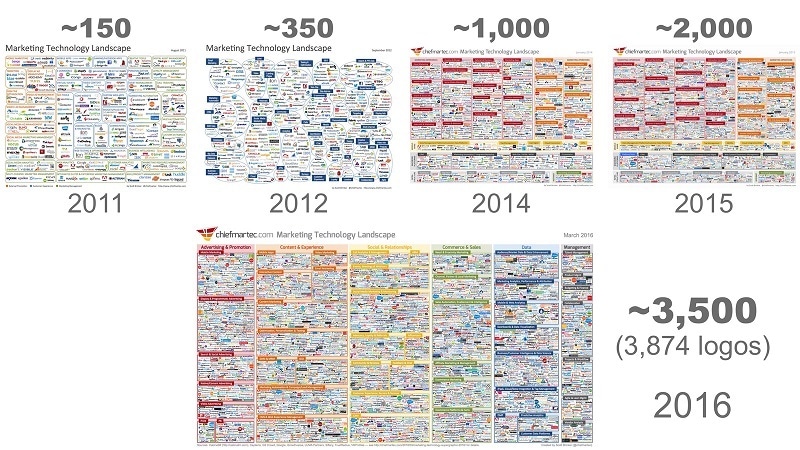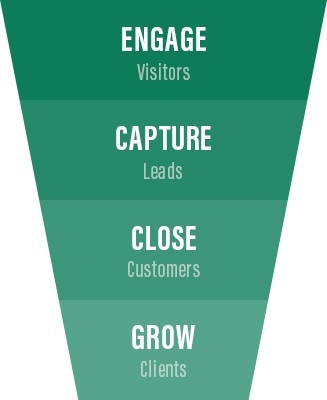
What is a Marketing Stack?
You can think of a marketing stack as the intersection between your digital marketing goals and the tools you use to achieve them. In B2B, defining your stack is essential: It leads to repeatable processes you can measure and improve and it keeps you from “reinventing the wheel” with custom software. What's more, the Marketing Tech industry is growing:
The Marketing Tech industry has grown over 3400% since 2011, increasing from under 100 companies to around 3,500 in 2016
Furthermore, the Marketing Technology landscape is expected to reach $32 Billion by 2018. Marketing Technology is here to stay, so if you don't know your "Marketing Stacks" from your "Automated Platforms" read on to ensure you don't get left behind...

You can see just how much the Marketing Technology industry has grown from this visual representation - credit Scott Brinker
Every company’s marketing stack is different, because every enterprise has different goals and selects trusted tools for approaching them. With a refined, trustworthy stack, you can create best practices that align marketing and operations: For example, you’ll know exactly how to leverage your tools to launch a product, promote a webinar, or get press for a new whitepaper.
What Should a Marketing Stack do?
Scientific marketing doesn’t just refer to marketing technical products to researchers — it also means taking a scientific approach to marketing itself. That means developing a hypothesis, testing results, and refining your rapport with the market based on your conclusions.
 Scientific marketing appears to be on the brink of a resurgence:
Scientific marketing appears to be on the brink of a resurgence:
Each “block” in your marketing stack should contribute to one or more of the goals of your sales funnel, making it easier to generate results from your strategy. You may use social media and content writing to engage visitors, a CMS to manage content and capture leads, and automated email programmes to nurture leads and develop relationships with your clients.
Put simply, the core of scientific marketing is data — collecting it, acting on it, and using it to outperform competitors.
Why now? Scientific enterprises are growing — and their purchasing process is becoming more sophisticated. In a recent survey, more sales and marketing leaders in scientific instrument companies reported a 6-12 month sales cycle than any other duration. They also reported a high degree of internal complexity in the business and more employees with PhDs.
When data isn’t the priority, marketing becomes more an art than a science: A whole company’s fate could hinge on a single decision-maker’s “hunch.” Some marketers have had success this way — but a much larger number have gambled and lost. Such an approach is a misreading of the market.
How to Build your own Scientific Marketing Stack
If your company invests a lot of effort on digital marketing, odds are you already have a marketing stack of some kind. Left to their own devices, marketing teams will choose and test tools internally, gradually developing preferences. However, this makes it harder to standardize and ensure all stakeholders can collaborate.
Let’s consider the elements of an effective marketing stack in the scientific realm:
1. Brand Awareness — Traffic Driver
Once your site is running and your sales funnel is intact, how can you get people interested in your brand? Generating traffic is the first step to success. All paid traffic, such as LinkedIn or Facebook ads, can be part of your efforts. If using paid advertising, it's critical to capture performance information on each ad variant and campaign.
Each paid traffic platform provides its own analytics suite that can join your marketing stack. If you use multiple paid traffic sources, ad management software may be helpful. Wordstream is a popular tool that builds on native analytics and provides contextual advice to optimize campaigns.
When investing money in paid traffic options, make sure you spend time optimizing your ad copy and CTAs. Ensure that the user has an incentive to click through; don't just lead them through to your website homepage, spend time creating a landing page that provides real value with a download, an eBook or an offer.
A traffic driver that can’t be overlooked is search engine optimization. Every page on your site has to contribute to SEO, which makes your site more visible in search results. There are dozens of SEO tools handling everything from keyword research to on-page optimization and beyond. Some, like Google’s Keyword Planner Tool, are free. Others, such as the popular keyword analyzer Market Samurai, require a subscription in exchange for robust features and personalized support.
If your site uses a content management system like WordPress, you’ll have access to many inexpensive SEO plug-ins. However, one of the most important tools in this area may be a simple Excel spreadsheet you can do to keep track of your content marketing and ensure fresh articles are posted regularly. Just because a tool is simple or familiar, it doesn't mean it can’t be helpful. As part of an integrated digital marketing strategy, Microsoft Office tools go a long way.
2. Social Media Management Platform
Social media lets you amplify your thought leadership content, enhance its shareability, and inform customers about new products or initiatives. LinkedIn, Twitter and Facebook are all useful tools, and new platforms are growing by the day. To ensure your message is disseminated effectively, consider an app that allows you to update your brand’s social media accounts at a glance. Scheduling future posts in advance can also give your accounts the appearance of more frequent activity. Originally focused on Twitter, Hootsuite has developed into a robust tool with access to more than 30 social networks. It includes a free version and business plans for as little as $9 annually.
3. Lead Generation Tool
Lead generation can be achieved through inbound or outbound marketing, though the deep, long-term relationships required by scientific marketing mean inbound is usually the way to go. Lead generation tools are intended to get users into your sales funnel. All forms of effective lead generation capture some information from the user, especially email address.
Content shared on platforms other than your own website does a large share of lead generation work, so look for software tools that integrate with those efforts and capture information. For example, Turnstile integrates email capture directly into video content. Slideshare allows you to amplify the reach of your thought leadership content and target decision-makers.
We run both inbound and outbound lead generation campaigns for clients across various different, targeted channels. Quality content, insight and thought leadership are stand-out methods of generating awareness and attracting relevant traffic within the SERPs. From there, ensuring that the reader can easily take action with CTAs (Calls to Action) or find what they need is essential to any lead generation campaign. Once you have your leads however, don't forget to follow up!
4. Lead Nurturing
Email Marketing Platform
Without email marketing, it’s fair to say your relationship nurturing efforts haven’t even begun yet. Email marketing is the cornerstone of an effective approach to maintaining contact with leads during their long decision-making process. A great way to ensure you are always on their mind
There are many enterprise email marketing tools, but it’s important to choose one that will scale with your needs. You don’t want to pay heavy fees to manage a list of just a few people. Thanks to optional A/B testing and sleek, pre-designed message formatting, MailChimp is a popular option for small and mid-sized businesses. Constant Contact is another, offering more templates but reduced testing. AWeber, which includes a 30-day free trial, also has a strong presence among B2B enterprises.
Automated Marketing
For businesses with more resources behind them, automated marketing options become a very valuable option. Services like Marketo and Pardot allow you to map reader journey's and automatically send content after certain "trigger events". However, to realize the full potential of such programmes, make sure you have the relevant resources to create the necessary content.
5. Analytics Platform
An analytics platform is what ties all these tools together, providing you with insights about what’s working and what’s not. In effect, your analytics tool generates the data that allows you to refine your processes. There is a plethora of metrics you can use to measure your campaigns, to find out about selecting and using an analytics platform, read our post: 5 Free Analytics Tools to Measure Your Marketing Metrics.
The key to streamlining and accelerating your digital marketing efforts is developing a stack that works for you. When a marketing technology stack is carefully designed and orchestrated, it makes day-to-day execution easier while informing quarterly and annual strategy. Check your existing tools for gaps and mismatches between their features and your needs. Before you know it, you'll have a menu of tools to truly fit your mission-critical business operations.